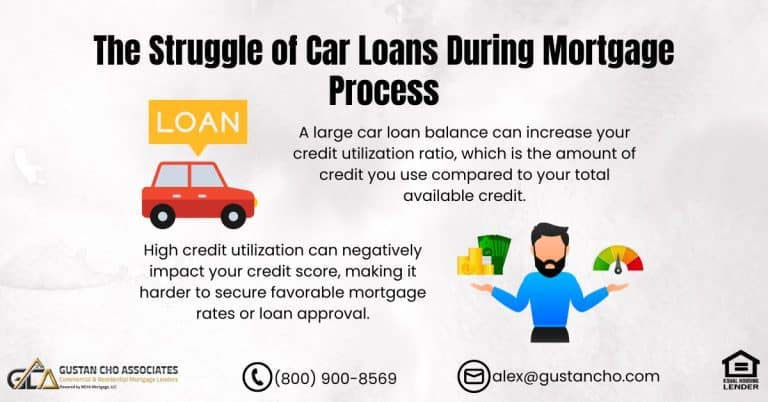This guide covers the process of qualifying borrowers for mortgage on home purchases and refinances. From the application stage to closing, the mortgage process has numerous steps. One of the most crucial steps is qualifying borrowers for mortgage during the initial call.
Even though many borrowers may have previously gone through the mortgage process, it often feels new because buying a home or refinancing is not frequent.
The mortgage industry is also constantly evolving with new rules and regulations. As a result, even experienced loan officers who take a break for a few years must start from scratch. This article will discuss and cover the process of qualifying borrowers for mortgage.
Steps in The Loan Process Qualifying Borrowers For Mortgage
The mortgage process involves numerous steps, making covering everything in a single blog post difficult. At Gustan Cho Associates, we will create a series of posts to explain the mortgage process in detail. This blog focuses on the steps that lead to an approve/eligible status per the findings of the automated underwriting system (AUS). Some lenders, like myself, with minimal to no lender overlays, rely solely on the AUS findings.
As long as the borrower meets the conditions set by the automated approval, there should be no issues, and the loan should close smoothly. This approach is crucial for efficiently qualifying borrowers for mortgage.
Ready to Buy or Refinance a Home? Let Us Help You Qualify for the Right Mortgage!
Contact us today to explore your options and get pre-approved.
What is the Qualifying Rate for a Mortgage?
The qualifying rate for a mortgage is the interest rate that lenders use to evaluate the ability of qualifying borrowers to make mortgage payments. This rate is typically higher than the actual rate you will pay, acting as a stress test to ensure you can manage potential future rate increases. The qualifying rate varies based on the lender and the specific mortgage product you are applying for when qualifying borrowers for a mortgage.
Here are some general points about qualifying rates:
- Fixed-Rate Mortgages: For a fixed-rate mortgage, the qualifying rate might be the actual contract rate plus a buffer (often 2%) or a set higher rate defined by the lender or regulator.
- Variable-Rate Mortgages: For variable-rate mortgages, the qualifying rate is usually higher than the initial rate offered to account for possible increases in the variable rate.
- Lender Policies: The qualifying rate may be subject to different policies from various lenders. It is important to verify the specific requirements with your lender.
Qualifying Borrowers For Mortgage With Initial Phone Interview
The initial phone interview is very important. A loan officer should have a note pad and pen. These are the following questions the loan officer should ask the borrower on the first phone interview.
- What state are you calling from?
- How much are the homes that you are interested in buying?
- Can you give me the tentative ball park figure of the property taxes that the homes you are shopping for are? H
- ow much are the annual homeowners’ insurance premiums? Are there homeowners association dues on homes that you are shopping for?
- Are the properties you are looking at in a flood zone. If so, how much are the flood insurance premium?
- These are important questions that will impact debt to income ratios when qualifying borrowers for a mortgage.
Qualifying Borrowers For Mortgage With Co-Borrowers
How many borrowers will be on the loan? Ask if both borrowers are employed? If husband and wife, and if one of the borrowers are not employed, do not use them as co-borrower because of no income. Both borrowers do not have to go on the loan and they can go on title.
Qualifying Borrowers For Mortgage on Income and Employment
Income and employment is one of the most important factors when qualifying borrowers:
- Ask them what they do for a living?
- Do they work full time?
- Do they get social security?
- Do they get child support and if they do, find out the ages of the children
- Reason you ask the age is because child support income needs to continue for the next three years to be used as qualified income
- If a child is 17 years old and the borrower gets child support income, that income cannot be used
- This is because most states child support stops once the minor turns 18 years old
- Social security income can be grossed up 15%
- Part time income, bonus income, and a second full time job income can be used
- It can only be used if borrower had a two year history of receiving that income
- The likelihood of a three continuation of that income is likely
1099 and self employment income can be used if and only if the borrower had two years history of receiving such income.
Qualifying Borrowers For Mortgage on How Much House Can I Afford
Determining “How much house can I afford?” is a key question only the homebuyer can answer. Only some monthly debt on credit reports can impact borrowers’ ability to repay a mortgage loan. Therefore, a loan officer should inquire about the borrower’s monthly debts. The largest debts homeowners usually have, aside from new housing payments, are car loan payments and student loan payments.
Loan officers should ask applicants if they have auto loans and, if so, what the monthly payments are. Borrowers must also disclose their student loans and the status of their payment agreements.
Individuals with existing student loan debt need to be aware of their total loan balance and the amount they must pay each month. If the student loan is deferred, 0.50% of the loan balance will be considered a hypothetical monthly debt. This applies unless the borrower can provide a written statement from the student loan provider specifying a hypothetical amortized monthly payment.
The statement from the student loan provider must detail the projected hypothetical monthly amortized payment. Additionally, the loan officer should be aware if the borrower’s student loan is deferred, in forbearance, or on an income-based repayment plan.
These inquiries are essential when qualifying borrowers for mortgage, as they ensure an accurate assessment of the borrower’s financial obligations.
Looking to Buy or Refinance? We’ll Help You Qualify for the Best Mortgage Loan!
Reach out now to get started on the path to homeownership or saving on your current mortgage.
Qualifying Borrowers For Mortgage With Collection and Charged-Off Accounts
Agency guidelines do not require borrowers to pay outstanding collections and charge-off accounts. Loan officers should ask borrowers if they have collection accounts with outstanding balances. Borrowers do not have to pay off outstanding collection accounts and charge offs to qualify for an FHA, VA, USDA, Conventional loans.
However, lenders do have to take into consideration outstanding collection accounts that total more than $2,000 in unpaid balances. This is because underwriters need to take 5% of the outstanding collection account balance and use it as part of the borrowers’ hypothetical monthly debt.
Qualifying Borrowers For Mortgage with Judgments and Tax Liens
Loan officers should know if borrowers have any outstanding judgments or tax liens. Borrowers can qualify for FHA loans with outstanding judgments or tax liens. However, need to have a written payment agreement with the judgment creditor or the Internal Revenue Service.
Need to have three months of payments. Provide the lender three months of canceled checks or bank statements showing borrowers have made three consecutive on time payments. Cannot prepay the whole three months upfront just to qualify for mortgage.
Qualifying Borrowers For Mortgage With Low Credit Scores Due To High Credit Card Balances
Ask them about their credit cards. Ask them about what each credit card limit is. What they owe on each credit card balance and what the monthly payments are. This question is important. It is because if the borrower has lower credit scores due to maxed-out credit cards, paying down credit card balances can skyrocket the borrower’s credit scores. Ask them if they know what their credit scores are. Most people we deal with have had credit issues.
Qualifying Borrowers For Mortgage With Our Typical Clientele Base
Over 80% of our borrowers are folks who got denied at the last minute by other lenders or could not qualify by other lenders so they know what their credit scores are. If they have a copy of a tri-merger credit report from a mortgage company that was pulled recently, have them email it.
Loan officers can do a quick review on it before running a new credit report and avoid dinging their credit scores. Ask them about their credit profile. Have they filed bankruptcy? Have they had a foreclosure. If so, when was it and when was the recorded date of the foreclosure or sheriff’s sale date. If short sale, when was the date of the short sale.
Qualifying Borrowers For Mortgage with Late Payments After Bankruptcy And Foreclosure
Loan officer should question borrowers about late payments after bankruptcy, or if they had a deed-in-lieu of foreclosure, standard foreclosure, or short sale. Another important question to be addressed are any late payments after bankruptcy or foreclosure. Most lenders WILL NOT APPROVE any borrowers with any late payments after bankruptcy, foreclosure, deed in lieu of foreclosure, or short sale.
Gustan Cho Associates will accept borrowers with late payments after bankruptcy and foreclosure if it was a one-time incident with a good letter of explanation.
Gustan Cho Associates will approve borrowers with late payments after a bankruptcy or a housing event only if they are able to get an approve/eligible per Automated Underwriting System.
Again, getting a mortgage loan approval with late payment after a bankruptcy or a housing event depends on the circumstances. If the loan officer seems that the borrower meets the initial mortgage qualification requirements the borrowers will be directed to the loan officer’s secure link to the online mortgage application website.
For example, once the borrower passes the initial mortgage interview with a loan officer at Gustan Cho Associates, the loan officer will direct them to our online application link and have them complete the APPLY NOW mortgage application. Once the borrower completes the online mortgage loan application, I will get an email alert and we then proceed to the next step with the mortgage application process.
Second Step in Qualifying Borrowers For Mortgage
Once the borrower has applied online and a loan officer has gotten the email alert through the mortgage CRM, the next step is to pull a tri-merger credit report: Make sure you log in all of your borrower’s information on the CRM system such as the borrower’s social security number, name, date of birth. Thoroughly review the borrower’s credit scores, credit report, payment history
Pay special attention that the borrowers do not have any credit disputes on their credit report with derogatory credit tradelines on non-medical collection accounts with an aggregate total of $1,000 or more and charge off accounts
Credit disputes on medical collections and non-medical collections with zero balance is allowed and exempt from credit disputes. IF CREDIT SCORES MEET MINIMUM CREDIT SCORE REQUIREMENTS AND IF YOU HAVE REVIEWED THE Credit Scores Versus Credit Report YOU CAN THEN PROCEED TO THE NEXT STEP OF THE MORTGAGE PROCESS.
Questionnaire Qualifying Borrowers For Mortgage Buying or Refinance
The third step in qualifying borrowers for mortgage buying or refinancing is to send out a one-page mortgage questionnaire for them to complete. Once they return it, you can run the mortgage file through the Automated Underwriting System. Below is the list of questions the borrowers need to answer:
- Number of years of schooling for borrower and co-borrowers
- Number of dependents listed on the Federal Income Taxes, if any, need their ages
- Email address for both (If married. can use the same one)
- What county is the property buyers are looking to purchase located in?
- How long have you been at your current address?
- If not 2 yrs or more, please provide additional addresses to cover that time period
- Do you get mail at the physical address?
- If NO; what is your mailing address
Employment Information of Borrowers
Are you self-employed or W2 wage earner?
- Name and address of employer
- What is their address
- What are the phone number of the borrower and cell number and best number to be contacted
- What is the position of their current job
- What type of business or industry is the borrower employed?
- How long has the borrower been employed at their current job?
- If not 2 years please provide all employment information and gaps in employment above to cover a 2 year period.
- Need to provide how many years in the same line of work, especially in the past two years?
- If the borrower is an hourly wage earner, how much per hour, amount of hours worked per week
Qualifying Borrowers For Mortgage With Part-Time and Other Income
If borrower receives overtime, bonus income, has they had that income in the past two years.
- If borrower is salaried employee, how much is the annual salary
- If they receive bonuses how much bonus do they receive
- Have they received bonus for the past two years?
- If borrower has part-time income many hours per week do they work
- Have they worked part-time for the past two years
- Is the part-time income likely to continue the next three years?
Bank and Asset Account Information
If the mortgage loan applicant is a renter, what is current rent amount.
- How does borrower pay rent, pay by check?
- If you do, do you have 12 months canceled checks and/or 12 months bank statements?
- Names and addresses of banks or other institutions where you hold asset accounts?
- Bank Name
- If more than one, break down balances for each below and list specific bank
- Checking Account Balance
- Savings Bank Account Balance
- Any retirement accounts? (401K, IRA, etc)
- Where is the account held
- What is the vested balance
- Are you a US citizen?
Property Information to Calcuate Proposed PITI
If you already own property please state following information:
- List the address(es) of the property
- Year the property was purchased
- Approximate value of the property if you were to sell it today
- What mortgage company do you have the first lien
- If you have a second mortgage what is the name of the second mortgage company name
- Annual property taxes of the properties that you own
- Annual Insurance premiums on all of the properties that you own
- Rent Amt Collected on the rental properties that you own
Government Data Monitoring
Government Monitoring Section Need To Be Completed:
- I do not wish to furnish this information(place X here >)
- are you Hispanic/Latino
- what race do you claim
- what sex do you claim
Once the borrower returns the above mortgage questionnaire form, the file is now ready to be submitted to Fannie Mae/Freddie Mac Automated Underwriting System for an automated approval.
After Borrowers Get An Approve/Eligible Per Automated Underwriting System, the mortgage process proceeds to the next step.
Buying or Refinancing a Home? Let Us Help You Qualify for the Perfect Mortgage!
Contact us today to find out how we can help you get pre-approved for a purchase or refinance loan.
Next Step After Automated Underwriting System Approval
Once borrowers get an automated underwriting system mortgage loan approval, the next step for the loan officer is to request all of the DOCUMENTS REQUIRED TO PROCESS LOAN:
- Documents Required To Process Loan needs to be carefully reviewed by the loan officer
- Make sure that there are no missing pages on bank statements, tax returns, divorce decree, bankruptcy paperwork, child support/alimony paperwork
- Any missing pages on mortgage docs can mean delays in the mortgage process
- Docs gathered need to be uploaded to each designated corporate site.
After all docs have been uploaded, a pre-approval letter can be issued. Gustan Cho Associates Mortgage Group is extremely careful in reviewing all docs prior to issuance of a pre-approval letter. Once a pre-approval letter has been issued, that means that we are confident that the loan will close and close in time.
Real Estate Purchase Contract
After the pre-approval letter has been issued by the loan officer, the home buyer will go out and shop for a home. Once the buyer decides on entering in Real Estate Purchase Contract the home buyer will email the executed real estate purchase contract to the loan officer. With the executed real estate purchase contract, the mortgage process is about to begin
Start of the Mortgage Process
Corporate headquarters will send the Initial Electronic Mortgage Disclosures to the borrower via email. The borrower will need to acknowledge the initial electronic mortgage loan disclosures and the Intent To Proceed is uploaded. The borrower’s mortgage application package will be assigned for processing and a mortgage processor will be assigned to the borrower.
The mortgage processor will order the appraisal. This should be completed in about a week so prior to submitting the file to underwriting. Home appraisal with be complete and back to the mortgage underwriter. The mortgage processor will be in contact with the loan officer and with work together in scrubbing the file until the file is totally prepped up for underwriting.
Mortgage Underwriting Stage of The Loan Process
Once the mortgage processor deems it complete, the file is then submitted to the underwriting department for approval process. A mortgage loan underwriter is assigned to the borrower’s mortgage file. A conditional approval should be issued within 24 to 48 hours upon receipt of a mortgage underwriter.
Conditional Mortgage Loan Approval
Upon getting a conditional mortgage loan approval, the mortgage processor, the loan officer, and the borrower need to get to work to gather all of the line items listed on the conditional loan approval. Once the mortgage processor has gathered all of the line items listed on the conditional loan approval, the processor then submits conditions back to underwriter for a clear to close.
A clear to close is when the underwriter has deemed the file complete. Gives it a thumbs up for the mortgage lender to close the loan. Once clear to close is issued, file goes in line for closing disclosure. Once closing dept and closing company have the numbers figured out it will be sent to the borrower. Once acknowledged they will have 3 business days to wait to sign loan docs.
Qualifying Borrowers For Mortgage For CTC and Closing
Once the borrower is issued a clear to close, the title company goes to work and prepares the Closing Disclosures: They get figures from both the borrowers and sellers side of the transaction. The actual figure, cash to close, from the borrower is figured out at this time. Borrower needs to wire the appropriate funds to the title company.
Under TRID MORTGAGE REGULATIONS, there is a three day waiting period to close on a home loan from the date of the clear-to-close. At closing, both sellers and buyers sign closing docs and the lender wires the funds to close and the borrower gets the keys to their home
What is the Qualified Mortgage Rule?
The Consumer Financial Protection Bureau (CFPB) established the Qualified Mortgage (QM) rule to set standards to ensure lenders provide loans that borrowers can reasonably expect to repay. Here are the key components of the Qualified Mortgage rule:
Ability to Repay (ATR)
Lenders must assess a borrower’s capacity to repay the loan reasonably and genuinely using verified and documented details about the borrower’s financial situation.
No Risky Loan Features
Qualified Mortgages cannot have certain risky features such as:
- Payments that cover only the interest
- A situation where the loan balance grows over time
- Terms that exceed 30 years
- A substantial payment that is due at the end of the loan term
Limits on Points and Fees
Points and fees for mortgages exceeding $100,000 are limited to 3% of the total loan amount. Smaller loans have higher caps for points and fees.
Debt-to-Income Ratio (DTI)
The borrower’s monthly debt payments, including the mortgage, exceed 43% of their gross monthly income. Nevertheless, loans eligible for purchase by Fannie Mae or Freddie Mac or those insured by specific government agencies may have varying DTI requirements.
Documentation Requirements
Borrowers must provide documented proof of income, assets, and employment to support their ability to repay the loan.
Safe Harbor and Rebuttable Presumption
- Safe Harbor: Lenders are presumed to have met the ability-to-repay requirement for Qualified Mortgages that are not higher-priced.
- Rebuttable Presumption: For higher-priced Qualified Mortgages, borrowers can challenge the lender’s compliance with the ability-to-repay requirement, but there is a presumption that the lender has complied if the loan meets QM criteria.
FAQs: Qualifying Borrowers For Mortgage on Purchase and Refinance
- 1. What does the mortgage qualification process involve? The mortgage qualification process includes multiple steps from application to closing. It involves assessing a borrower’s ability to repay the loan, verifying income and employment, checking credit history, and more. The process can be complex and is often new to many borrowers, even those who have gone through it before.
- 2. Why is the initial phone interview important? The initial phone interview allows the loan officer to gather crucial information about the borrower’s financial situation, property details, and other relevant factors. This helps assess the borrower’s eligibility and effectively guides them through the mortgage process.
- 3. What is the qualifying rate for a mortgage? The qualifying rate is the lender’s interest rate, used to assess your ability to make mortgage payments. It is often higher than the actual rate you will pay and serves as a stress test to ensure you can handle potential rate increases in the future.
- 4. What questions should a loan officer ask during the first call? Loan officers should ask about the borrower’s location, property details (e.g., price, taxes, insurance, HOA dues), and any flood zone concerns. These questions help estimate debt-to-income ratios and other important metrics.
- 5. How should borrowers with co-borrowers be qualified? Loan officers should verify if both borrowers are employed. If one is not employed, they should not be used as a co-borrower for income qualification purposes. Both can still be on the title.
- 6. What income and employment details are necessary? Loan officers should ask about the borrower’s job, full-time status, social security income, child support, and any part-time or bonus income. Self-employment and 1099 income require a two-year history to be considered.
- 7. How should monthly debts be assessed? Loan officers should inquire about all monthly debts, including auto and student loans. For student loans in deferment, 0.50% of the loan balance is used as a hypothetical monthly debt unless an amortized payment is provided.
- 8. What about collections and charged-off accounts? Agency guidelines do not require paying off collections or charge-offs to qualify for most loans. However, underwriters must consider collections with unpaid balances over $2,000 by adding 5% as a hypothetical monthly debt.
- 9. How are judgments and tax liens handled? Borrowers with outstanding judgments or tax liens can qualify if they have a payment agreement and have made at least three consecutive on-time payments.
- 10. What if the borrower has low credit scores due to high credit card balances? Paying down credit card balances can significantly improve credit scores. Loan officers should ask about credit card limits, balances, and monthly payments.
- 11. What happens after the initial qualification? After the initial qualification, the borrower completes an online application, and the loan officer pulls a tri-merge credit report. The file is then reviewed, and any credit disputes or derogatory accounts are addressed before proceeding.
- 12. What is the next step after approval for the approval of the Automated Underwriting System (AUS)? After AUS approval, the loan officer requests all necessary documents. Once everything is reviewed and completed, a pre-approval letter is issued. The borrower can then shop for a home and submit a purchase contract.
- 13. What happens during the closing process? The title company prepares the Closing Disclosures, and the borrower wires the funds to the title company. Under TRID regulations, there is a three-day waiting period before closing. Both parties sign the closing documents, the lender wires the funds, and the borrower receives the keys.
- 14. What is the Qualified Mortgage (QM) rule? The QM rule, established by the CFPB, sets standards to ensure lenders provide loans that borrowers can reasonably expect to repay. It includes requirements for verifying the borrower’s ability to repay, limiting risky loan features, and capping points and fees.
- 15. What are the key components of the QM rule? The QM rule includes verifying the ability to repay, prohibiting risky loan features (like interest-only payments and negative amortization), setting limits on points and fees, and requiring documentation of income and employment.
For more detailed information or specific inquiries, please refer to the full guide or contact a us at 800-900-8569. You may also email us at gcho@gustancho.com. The team at Gustan Cho Associates is available 7 days a week, on evenings, weekends, and holidays. Speak With Our Loan Officer for Mortgage Loans
This blog about Qualifying Borrowers For Mortgage on Purchase and Refinance was updated on May 31st, 2024.
Ready to Qualify for a Mortgage on a Purchase or Refinance? We’re Here to Help!
Reach out now to get pre-approved and start your journey to homeownership or better mortgage terms.










